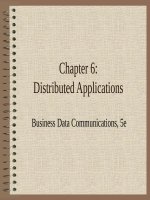Business data communications 5e by stallings chapter 02
Bạn đang xem bản rút gọn của tài liệu. Xem và tải ngay bản đầy đủ của tài liệu tại đây (52.05 KB, 15 trang )
Chapter 2 : Business Information
Business Data Communications, 5e
Analog Data
• Continuous signal
• Expressed as an oscillation (sine wave
format) of frequency
• Information rate and channel capacity are
measured in hertz (Hz) of bandwidth (1 Hz
= 1 cycle per second).
Basic Analog Terms
• Wave frequency: Number of times a cycle
occurs in given time period
• Wave amplitude: Height of a wave cycle
• Hertz (Hz): The number of times a wave
cycle occurs in one second (commonly
used measure of frequency)
Types of Information
•
•
•
•
Audio
Data
Image
Video
Understanding Audio
• What makes sound? Vibration of air
• How can we record that vibration?
• How can we convert that to an electrical
signal?
Digital Audio
• For good representation, must sample amplitude
at a rate of at least twice the maximum frequency
• Measured in samples per second, or smp/sec
• Telephone quality: 8000smp/sec, each sample
using 8 bits
– 8 bits * 8000smp/sec = 64kbps to transmit
• CD audio quality: 44000smp/sec, each sample
using 16 bits
– 16 bits * 44000smp/sec = 1.41mbps to transmit clearly
Networking Implications
for Voice Communication
• Requires powerful, flexible intralocation
facility, and access to outside services (e.g.
telcos)
• In-house alternatives
– PBX (perform switching in the customer side)
– Centrex (perform switching in the telcos)
Digital Data
• Represented as a sequence of discrete symbols
from a finite “alphabet” of text and/or digits
• Rate and capacity of a digital channel measured
in bits per second (bps)
• Digital data is binary: uses 1s and 0s to represent
everything
• Data encoded in strings
– ASCII, IRA, UTF, etc
• Data is often redundant (why?)
Data Networking Implications
• Vary significantly based on application and data
types
– Example: Transferring financial transactions data
from CitiBank-Taipei to CitiBank-NY (Not just realtime, but also . . . )
– Daily reports vs monthly reports
– DHL parcel tracking
• Response time often a key component
• What sort of technologies are needed to support
such applications?
Understanding Images
• Vector graphics
– Collection of straight and curved line segments
– Image described as a collection of segments
• Raster graphics
– Two-dimensional array of “spots” (pixels)
– Also called “bitmap” image
• In terms of memory, which kind of graphic needs
more memory?
Image and Document Formats
• Common Raster Formats
– JPEG
– GIF
• Common Document Formats
– Postscript
– Both include text and graphics
Networking Implications
for Image Data
• More pixels=better quality=larger size
• More compression=reduced quality=increased
speed
– “Lossy” gives from 10:1 to 20:1 compression
– “Lossless” gives less than 5:1
• Format (vector vs bitmapped/raster) affects size
and therefore bandwidth requirements
• Choices in imaging technology, conversion, and
communication all affect end-user’s satisfaction
Video Communication
• Sequences of images over time
• Same concept as image, but with the
dimension of time added
• Significantly higher bandwidth
requirements in order to send images
(frames) quickly enough
• Similarity of adjacent frames allows for
high compression rates
Performance Measure:
Response Time
• User response time
• System response time
• Network transfer time (throughput)
Bandwidth Requirements
• Review Figure 2.7
• What happens when bandwidth is
insufficient?
• How long does it take to become impatient?
– Let us feel about that . . .
– YouTube
• Is data communication ever “fast enough”?









